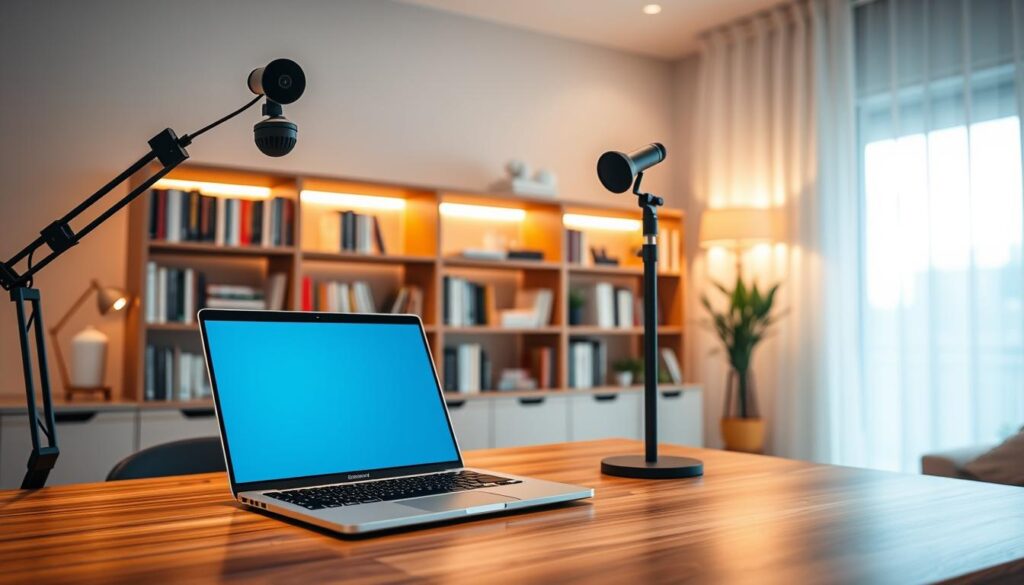Setting Up the Ultimate Virtual Study Space
As a new term begins, students and online learners worldwide are gearing up for a fresh academic challenge. A dedicated virtual study space is crucial for success in this digital age.
A well-designed virtual study area can significantly enhance productivity and focus, leading to a more effective learning experience.
By crafting the perfect virtual study environment, learners can optimize their study sessions, stay organized, and achieve their academic goals more efficiently.
We’re here to guide you through the process of creating an ideal virtual study space that supports your learning journey and helps you succeed.
Why Your Virtual Study Environment Matters
A well-designed virtual study space can significantly impact your productivity and focus. Whether you’re attending classes from your bedroom, a corner of the living room, or a shared space, a thoughtfully organized study area can enhance your overall learning experience.
By creating a dedicated virtual study environment, you can minimize distractions and stay motivated. Consider incorporating tools and resources that facilitate effective learning, such as whiteboards for study rooms, to make your study sessions more enjoyable and productive.

A well-organized virtual study space is essential for achieving academic success. By prioritizing your virtual study environment, you can improve your overall productivity and stay focused on your goals.
Essential Physical Components of Your Study Space
Creating an effective study space is crucial for academic success, and it begins with the right physical components. A well-designed study area can significantly enhance your productivity and focus.
Investing in comfortable furniture is paramount. A high-quality chair that provides good back support and encourages proper posture is essential for extended learning sessions. You can find great deals on study desks and chairs at affordable prices, making it easier to set up your study space without breaking the bank.
Good lighting is another critical element. Proper lighting can reduce eye strain and improve your overall study experience. Consider using a combination of natural and artificial light sources to create an ideal environment.
By focusing on these essential physical components, you can create a study space that is conducive to learning and helps you achieve your academic goals.
Technical Setup for Seamless Learning
To ensure a smooth online learning journey, it’s essential to have the right technical setup in place. This involves equipping yourself with the necessary tools and equipment to support your educational endeavors.
Having a reliable computer or tablet with high-speed internet is fundamental. Additionally, you may need specific software or tools recommended by your educational institution or course providers.
Webcams and Microphones
High-quality webcams and microphones are crucial for interactive online learning. They enable clear communication and participation in virtual classes. When selecting a webcam, consider factors like resolution, frame rate, and compatibility with your computer.
For microphones, look for options that offer clear audio and noise cancellation to minimize distractions. USB microphones are popular for their ease of use and good sound quality.

External storage devices are important for backing up your data and expanding your storage capacity. Options include external hard drives and cloud storage services. When choosing external storage, consider the storage capacity, data transfer speed, and compatibility with your devices.
Cloud storage services offer the advantage of accessing your files from anywhere and collaborating with others. It’s a good practice to maintain backups of your important files to prevent data loss.
Digital Tools for an Effective Virtual Study Space
With multiple learning platforms to juggle, students need a robust set of digital tools to stay organized. Managing a full course load across various platforms like Canvas, Piazza, Zoom, and BB Collaborate can be overwhelming.
Digital tools are essential for creating a seamless and productive virtual study environment. One of the most critical digital tools is cloud storage, particularly Google Drive. It allows students to store and access their files from anywhere, at any time.
Google Drive Organization Strategies
Organizing files on Google Drive is crucial for efficiency. Students can create folders for each course, and subfolders for different types of materials, such as lectures, assignments, and readings.
Using clear and descriptive file names and taking advantage of Google Drive’s search functionality can further enhance organization.

In addition to Google Drive, having a backup solution is vital to prevent data loss. Services like Google Drive, Dropbox, and OneDrive offer automatic backup options.
Students should also consider external hard drives for additional backups. Regularly backing up important files ensures that academic work is safe and accessible.
By leveraging these digital tools and strategies, students can create a highly effective virtual study space that enhances productivity and reduces stress.
Setting Up the Ultimate Virtual Study Space: Step-by-Step Guide
To set up an effective virtual study environment, follow this step-by-step guide. Creating a productive virtual study space is crucial for achieving academic success.
Choosing the right location is the first step to creating a productive study space. Look for a spot that is quiet, comfortable, and free from distractions. Ensure that your study area is dedicated solely to studying, helping you stay focused and avoid procrastination.

Once you have selected your study location, it’s essential to set up your technical equipment. This includes a reliable computer, a stable internet connection, and any other necessary tools such as a headset or microphone for online classes. Make sure all your equipment is in good working condition to avoid any disruptions during your study sessions.
Next, consider the digital tools you will need to enhance your virtual study experience. This can include productivity software, online resources, and apps designed to help you stay organized and focused. Integrating these tools into your study routine can significantly improve your efficiency and effectiveness.
Minimizing digital distractions is another critical aspect of maintaining a productive virtual study space. This can be achieved by turning off notifications on your devices, using website blockers to limit access to distracting websites, and creating a conducive study environment that promotes concentration.
By following this step-by-step guide, you can create an ultimate virtual study space that supports your academic goals and enhances your learning experience.
Ergonomics and Health Considerations
When setting up your virtual study space, prioritizing ergonomics and health considerations is essential. A well-designed study area can significantly impact your productivity and overall well-being.
One key aspect is ensuring proper posture. This can be achieved by using a chair with adequate lumbar support and positioning your computer monitor directly in front of you, at a distance of about 20-25 inches. The top of the monitor should be at eye level or slightly below.
Comfortable furniture is also crucial. Consider using an ergonomic chair and a desk that allows you to work with your elbows at a 90-degree angle. Minimizing the risk of eye strain is another important consideration; follow the 20-20-20 rule: every 20 minutes, look away from your screen and focus on something 20 feet away for 20 seconds.
By focusing on these health considerations, you can create a virtual study space that supports both your academic success and your physical health.
Creating a Distraction-Free Virtual Environment
Minimizing distractions in your virtual study environment can significantly enhance your productivity and learning experience. To achieve this, it’s essential to leverage the right tools and strategies.
One effective way to minimize digital distractions is by using apps and website blockers. Tools like Freedom, SelfControl, and StayFocusd can block social media, email, and other distracting websites during your study sessions. By limiting access to non-essential sites, you can maintain your focus on the task at hand.
Implementing a distraction-free virtual environment also involves organizing your digital workspace. This includes closing unnecessary tabs on your computer, silencing notifications, and using a dedicated study account on your devices. By doing so, you create a clean and focused digital space that supports your learning objectives.
Furthermore, establishing a routine can help you stay on track. Set specific study times, take regular breaks, and use your breaks to relax and recharge. This structured approach can help you maintain a healthy balance between study and leisure time, reducing the likelihood of burnout.
By combining these strategies, you can create a distraction-free virtual environment that enhances your learning experience and boosts your productivity. This, in turn, can lead to better academic performance and a more fulfilling educational journey.
Conclusion: Evolving Your Virtual Study Space
Creating the perfect study space for online learning is a continuous process. It’s about crafting an environment that adapts to your evolving needs, minimizes distractions, and enhances your overall well-being.
As you continue on your learning journey, regularly assess your virtual study space to ensure it remains optimized for your success. Make adjustments as needed to stay focused and motivated.
Evolving your virtual study space is about being intentional with your setup, leveraging the right digital tools, and maintaining a healthy and ergonomic environment. By doing so, you’ll be well on your way to creating a virtual study space that truly supports your academic goals.
By continually refining your virtual study space, you’ll be able to maximize your productivity and achieve your desired outcomes in your online learning endeavors.







